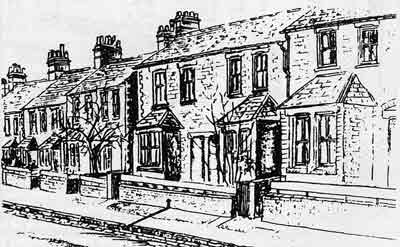ABOUT JERICHO - STREETS
Juxon Street

Houses in Juxon Street have narrow walled gardens
One of Jericho's more uniform streets, now owned by Lucys.
Posted - December 27, 2012Juxon Street, named after William Juxon, President of St. John's College, 1621 -33, was part of the farmstead of Walton Manor owned by that college. When the farm was sold the site was left unoccupied until William Wilkinson, the college architect, was commissioned to lay out the whole northern part of the estate in 1860. Until that time a high gravel ridge, known as Cabbage Hill, lay between Woodstock Road and Port Meadow, stretching north from Walton Street. An old drover road leading to the entrance to the Meadow by Aristotle Lane skirted the west side of this ridge under a steep, 30ft gravel bank which ran from the junction with the present day St. Bernard's Road with Walton Street. It was along this route that Charles I, with 6,000 men, escaped from Oxford under the noses of the Parliamentarians in 1644.
When the London, North West Railway Company bought a strip of land along Port Meadow to build its new line to Bletchley it needed gravel for ballast. Between 1849 and 1852 the whole ridge was carted away using a tramway over Aristotle Bridge. More gravel was brought up from a pit at Bevington Road and the narrow, sunken Horse and Jockey Lane was straightened and widened into St. John's Road, now St. Bernard's Road. With the land planed off and levelled, Juxon Street and Kingston Road were laid out. Building began in Juxon Street in 1876 and in Walton Well Road in the 1880s.
Like St. John's estate to the south, Juxon Street was designed to provide small villa style properties for middle class families. The Gothic touches characteristic of Richmond Road were replaced by a more formal Edwardian taste but each house had the same narrow, walled front garden, inset porch and heavy bay window. Nor did the residents even consider themselves to be living in Jericho then, despite the connection through Allam Street to Cranham Street built in 1877, regarded as a poor and somewhat rough area. Cranham Street formed part of the Juxon development of St. John's though the terraced cottages erected there were designed for working men's families on the usual two-up, two-down plan.
Much of the northern side of the street was bought by Lucy's Eagle Ironworks to house its staff. After Jericho was declared a residential zone many of the houses were let out for multi-occupancy to students. This led to many complaints about poor maintenance, over-crowding, noise, neglected gardens and cluttered pavements. Some properties at the west end of the street were demolished to make way for flats but with the property boom of the late 1980s, the street was transformed into the present inner-city residential street.
Why Hart Street?
Hart Street was named after the Printer to the University 1883-1915.
About the church bells?
Originally the Church only had the single ‘Barney’s Bell’. In 1890, when the clock was installed, it was decided to add a set of tubular bells to ring the chimes and the hour strike, as well as a tune or ‘carillon’. The are driven by an elaborate mechanical contraption.